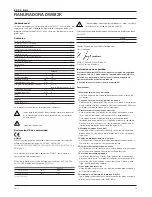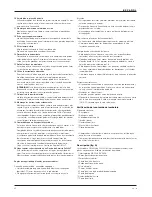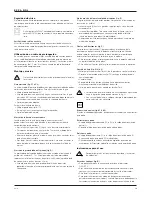
E N G L I S H
13
en - 3
• The cable wire colours, or a letter, will be marked at the connection
points of most good quality plugs. Attach the wires to their respective
points in the plug (see below). Brown is for Live (L) (2) and Blue is for
Neutral (N) (4).
• Before replacing the top cover of the mains plug ensure that the cable
restraint (3) is holding the outer sheath of the cable firmly and that the
two leads are correctly fixed at the terminal screws.
Never use a light socket.
Never connect the live (L) or neutral (N) wires to the earth pin
marked E or
.
For 115 V units with a power rating exceeding 1500 W, we recommend to
fit a plug to BS4343 standard.
Using an extension cable
If an extension cable is required, use an approved extension cable suitable
for the power input of this tool (see technical data). The minimum
conductor size is 1.5 mm
2
. When using a cable reel, always unwind the
cable completely. Also refer to the table below.
Conductor size (mm
2
)
Cable rating (Amperes)
0.75
6
1.00
10
1.50
15
2.50
20
4.00
25
Cable length (m)
7.5
15
25
30
45
60
Voltage
Amperes
Cable rating (Amperes)
115
0 - 2.0
6
6
6
6
6
10
2.1 - 3.4
6
6
6
6
15
15
3.5 - 5.0
6
6
10
15
20
20
5.1 - 7.0
10
10
15
20
20
25
7.1 - 12.0
15
15
20
25
25
-
12.1 - 20.0
20
20
25
-
-
-
230
0 - 2.0
6
6
6
6
6
6
2.1 - 3.4
6
6
6
6
6
6
3.5 - 5.0
6
6
6
6
10
15
5.1 - 7.0
10
10
10
10
15
15
7.1 - 12.0
15
15
15
15
20
20
12.1 - 20.0
20
20
20
20
25
-
Assembly and adjustment
Prior to assembly and adjustment always unplug the tool.
Adjustable fence (fig. C1 & C2)
The adjustable fence (6) allows you to precisely set the point where the
slots for the biscuits are cut. To set the fence height:
• Slacken the locking knob (9).
• Set the height adjuster (4) as required. With the fence set to 90°,
the scale under the locking knob reads the distance between the
centre of cutter and the surface of the fence.
• Tighten the locking knob.
To set the fence angle:
• Slacken the star knob (11).
• Tilt the fence into the required angle.
• Tighten the star knob.
Jointer base markings
When working without the fence, for example when making T-joints, you
can use the markings on the jointer base for proper alignment of the tool.
• Set the fence to the 0° position as described above.
• For workpieces with a thickness of 19 mm, use the edge of the base
as a reference for centring.
• For other workpieces, use the red centreline markings to align the tool.
• Two of the markings indicate the length of the cut. In order to prevent
breaking through the workpiece, make sure that the workpiece extends
beyond these markings.
Plunge depth adjustment (fig. D)
The plunge depth must be set to match the biscuit size. The numbers 0,
10 and 20 on the depth adjusting knob correspond with the biscuit size.
The M represents the maximum cutting depth of approx. 22 mm.
• Turn the depth adjusting knob (8) into the required position, aligning the
appropriate number with the red marking on the tool.
Plunge depth fine adjustment (fig. E)
The fine adjustment is used to eliminate possible tolerances in the size of
the biscuit slots.
• Raise the fence (6) to its upper position as described above.
• Insert the Torx screwdriver as shown and adjust the plunge depth as
required by turning the screw (turn clockwise to decrease the plunge
depth).
• Check the setting by making a trial cut in a piece of scrap wood.
Anti-slipping pins (fig. F)
The anti-slipping pins (7) help to reduce the tendency of the biscuit jointer
to slide to the right when cutting. When working on visible parts of the
workpiece, you may want to retract them in order to avoid scratching.
• To retract the pins, rotate them slightly clockwise using a flat
screwdriver.
• To use the pins again, rotate them slightly counterclockwise.
Replacing the blade (fig. G, H & J)
• Remove the four Torx screws (12) from the base plate and take off the
cover.
• Depress the spindle lock (10) and remove the flange by turning it
counterclockwise.
• Change the blade.
• Tighten the flange securely by turning it clockwise while keeping the
spindle lock depressed.
• Mount the cover plate and tighten the Torx screws.
• Make sure that the teeth of the cutter point in
counterclockwise direction as shown (fig. H).
• After replacing the blade, always check the cutting depth and
adjust if necessary.
Dust extraction (fig. K1 & K2)
Using the appropriate adapter, you can connect either a dustbag or a dust
extractor.
Dust extractor
• Insert the appropriate adapter (13) or (14) into the dust extraction outlet (5).
• Connect the dust extractor hose to the adapter.
Содержание DW682K
Страница 1: ... DW682K ...
Страница 3: ...A 8 10 2 11 6 4 3 7 9 1 5 ...
Страница 4: ...12 E G H 1 2 C1 C2 B D 6 F 11 9 4 6 8 7 ...
Страница 5: ...13 5 J M N1 N2 N3 L 10 K1 0 10 20 15 25 cm 5 7 5 cm K2 15 14 5 ...
Страница 6: ...Q1 N4 R1 R2 R3 S1 P 5 7 5 cm 15 25 cm 15 25 cm Q2 ...
Страница 7: ...U1 V2 U3 U4 U2 T V1 S2 ...
Страница 8: ...V3 V4 V5 ...































